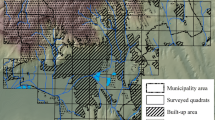Abstract
Over fifty years of research data from various sources were compiled and analyzed in order to determine the effect of urbanization on centipede diversity in the Wielkopolska-Kujawy Lowlands of western Poland. Urbanization has had a significant effect on species composition and community structures. However, it has not reduced overall species richness and diversity in the centipede fauna. The centipede fauna from built-up areas was found to be rich and varied. The habitats with the highest levels of species richness were the city of Poznań and the beech forests in the surrounding region.
Similar content being viewed by others
References
Albert A.M. 1982. Species spectrum and dispersion patterns of chilopods in three Solling habitats. Pedobiologia 23: 337–347.
Andersson G. 1983. The Chilopod fauna in the vicinity of Göteborg — a comparison between collecting results obtained in the 1920s and the 1970s. Acta Entomol. Fenn. 42: 9–14.
Balogh J. 1958. Lebensgemeinschaften der Landtiere. Grundzüge der Zoozönologie. Akadémiai Kiadó, Budapest, 560 pp.
Bornebush C.H. 1930. The fauna of the forest soil. Forst. Vaes. Danm. 11, 225 pp.
Christian E. 1996. Die Erdläufer (Chilopoda: Geophilida) des Wiener Stadtgebietes. Verh. Zool.-Bot. Ges. Österreich 133: 107–132.
Dunger W. & Voigtländer K. 1990. Succession of Myriapoda in primary colonization of reclaimed land, pp. 219–227. In: Minelli A. (ed.), Proc. 7th Int. Congress of Myriapodology, Leiden.
Enghoff H. 1973. Diplopoda and Chilopoda from suburban localities around Copenhagen. Vidd. Meddr. Dansk Naturh. Foren. 136: 43–48.
Everitt B.S., Landau S. & Leese, M. 2001. Cluster Analysis. Arnold, London, 248 pp.
Fründ H.-C. 1989. Untersuchungen zur Biologie städtischer Böden. 5. Epigäische Raubarthropoden. Verh. Ges. Ökol. 18: 201–209.
Fründ H.-C. 1991. Zur Biologie eines Buchenwaldbodens 14. Die Hundertfüßern (Chilopoda). Carolinea 49: 83–94.
Geoffroy J.J. 1979. Les peuplements de Chilopodes et de diplopodes d’une chęnaie-charmaie. These du Diplôme de Docteur, L’université Pierre et Marie Curie, Paris, 179 pp.
Horn H.S. 1966. Measurement of “overlap” in comparative ecological studies. Amer. Natur. 100: 419–424.
Jackowiak B. 1990. Antropogeniczne przemiany flory roślin naczyniowych Poznania. Wyd. Nauk. UAM, Poznań, 232 pp.
Kaczmarek J. 1952. Pareczniki (Chilopoda) Wielkopolski i Ziemi Lubuskiej (1. Lithobiomorpha). PTPN, Pr. Kom. Biol. 13: 311–339.
Kaczmarek J. 1964. Scolopendromorpha i Geophilomorpha Polski Północno-Zachodniej. Bad. Fizj. Pol. Zach. 14: 59–68.
Kaczmarek J. 1977. Pareczniki (Chilopoda) rezerwatu “Dębina” pod Wągrowcem. Bad. Fizj. Pol. Zach., Seria C — Zoologia 30: 149–153.
Kaczmarek J. 1979. Pareczniki (Chilopoda) Polski. Wyd. Nauk. UAM, Poznań, 99 pp.
Kaczmarek J. 1980. Pareczniki (Chilopoda). Katalog Fauny Polski. PWN, Warszawa, 43 pp.
Kaczmarek J. 1989. Pareczniki (Chilopoda) wybranego lasu grądowego Wielkopolski na przykładzie rezerwatu Jakubowo. Fragm. Faun. 32(17): 369–379.
Kondracki J. 2002. Geografia regionalna Polski. PWN, Warszawa, 441 pp.
Leśniewska M. 1996. Centipedes of Poznań town (Poland), pp. 221–224. In: Geoffroy J.-J., Mauriès J.-P. & Nguyen Duy-Jacquemin M. (eds), Acta Myriapodologica. Mém. Mus. Nat. Hist. Nat. 169.
Leśniewska M. 1997. Zgrupowanie pareczników (Chilopoda) w rezerwacie przyrody “Buki nad jeziorem Lutomskim”. Wyd. Nauk. UAM, Poznań, 83 pp.
Leśniewska M. 2004. Lamyctes emarginatus (Newport, 1844) w Wielkopolsce. Bad. Fizj. Pol. Zach. Seria C — Zoologia 50: 45–51.
Leśniewska M., Koralewska-Batura E. & Błoszyk J. 2005. Centipede communities in oak-hornbeam forests of different ages and exploitation in Wielkopolska (Poland). Peckiana 4: 69–79.
Leśniewska M. & Wojciechowski J. 1992. Haplophilus subterraneus (Shaw, 1794) (Chilopoda, Geophilomorpha) — nowy dla fauny Polski przedstawiciel pareczników. Prz. Zool. 36: 133–136.
Lewis J.G.E. 1985. Centipedes entering houses with particular reference to Geophilus carpophagous Leach. Entomol. Mon. Mag. 121: 257–259.
Magurran A.E. 1996. Ecological Diversity and its Measurement. Chapman & Hall, London, 179 pp.
Országh I. & Országhová Z. 1997. Centipedes (Antennata, Chilopoda) from Danubian floodplain woods (south-western Slovakia). Entomofauna Carpathica 9: 83–91.
Tajovský K. 1999. Impact of inundations on terrestrial arthropod assemblages in Southern Moravian floodplain forests, Czech Republic. Ekológia (Bratislava) 18,Suppl. 1: 177–184.
Tischler W. 1980. Asseln (Isopoda) und Tausendfüsser (Myriapoda) eines Stadtparks im Vergleich mit der Umgebung der Stadt: zum Problem der Urbanbiologie. Drosera 80: 41–52.
Trojan P. 1994. The shaping of the diversity of invertebrate species in the urban green spaces of Warsaw. Memorabilia Zool. 49: 167–173.
Tuf I. 2000. Communities of centipedes (Chilopoda) in three floodplain forests of various age in Litovelské Pomoraví (Czech Republic), pp. 327–332. In: Wytwer J. & Golovatch S. (eds), Progress in Studies on Myriapoda and Onychophora, Warszawa, Fragm. Faun. 43(Suppl.).
Voženílková K. & Tajovský K. 2001. Centipedes (Chilopoda) of colliery spoil heaps in the Sokolov region, Czech Republic. Myriapodologica Czecho-Slovaca 1: 81–84.
Wignarajah S. & Phillipson J. 1977. Numbers and biomass of centipedes (Lithobiomorpha: Chilopoda) in a Betula-Alnus woodland in N. E. England. Oecologia 31: 55–66.
Wytwer J. 1990. Chilopoda of linden-oak-hornbeam (Tilio-Carpinetum) and thermophilous oak forests (Potentillo albae-Quercetum) of the Mazovian Lowland. Fragm. Faun. 34(6): 73–94.
Wytwer J. 1995. Faunistical relationships between Chilopoda of forest and urban habitats in Mazovia. Fragm. Faun. 38(2): 87–133.
Wytwer J. 1996. Chilopoda of urban greens in Warsaw, pp. 213–220. In: Geoffroy J.-J., Mauriès J.-P. & Nguyen Duy-Jacquemin M. (eds), Acta Myriapodologica. Mém. Mus. Nat. Hist. Nat. 169.
Zapparoli M. 1992. Centipedes in urban environments: record from the city Rome (Italy). Ber. Nat. Med. Verein. Innsbruck, Suppl. 10: 231–236.
Zych M. 1989. Remarks on distribution of Lithobius microps Meinert (Chilopoda, Lithobiomorpha). Przegl. Zool. 32: 332–335. [In Polish]
Author information
Authors and Affiliations
Corresponding author
Rights and permissions
About this article
Cite this article
Leśniewska, M., Leśniewski, P. & Szybiak, K. Effect of urbanization on centipede (Chilopoda) diversity in the Wielkopolska-Kujawy Lowlands of western Poland. Biologia 63, 711–719 (2008). https://doi.org/10.2478/s11756-008-0121-0
Received:
Accepted:
Published:
Issue Date:
DOI: https://doi.org/10.2478/s11756-008-0121-0




